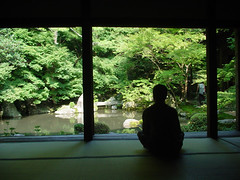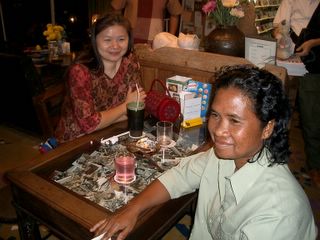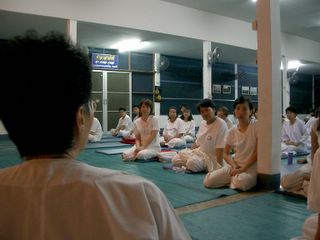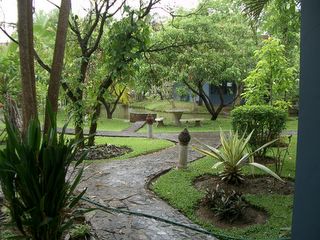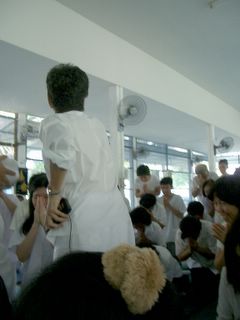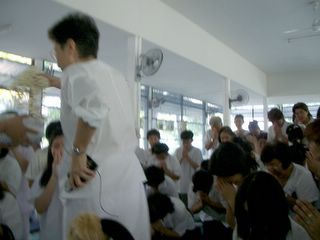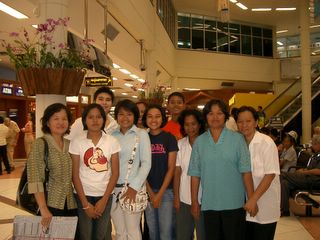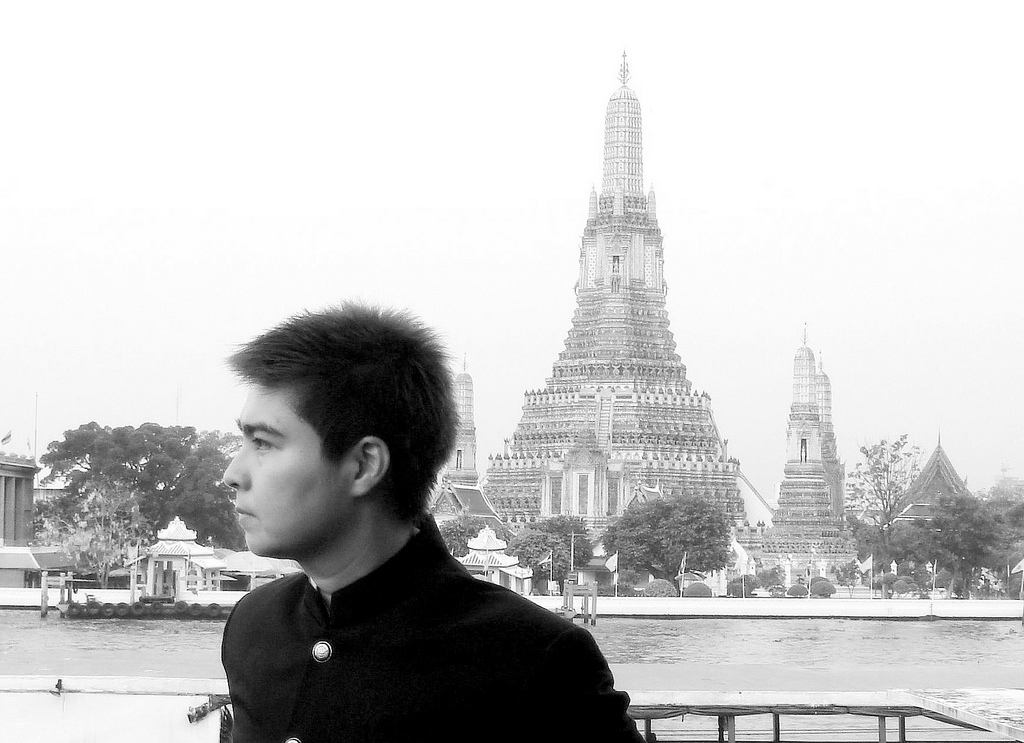Sunday, November 20, 2005
Dhamma Suksa Tho Exam
Saturday, August 06, 2005
Bangkok Post Sunday 31 July 2005 - Taking it to the streets

Story by ATIYA ACHAKULWISUT Photo by SMITH SUTIBUT
Popular writer and monk Phra Maha Wudhijaya Vajiramedhi believes that the Sangha must employ modern means to promote dharma to reach members of the new generation.
Best-selling monk Phra Maha Wudhijaya Vajiramedhi is using modern means to promote and popularise the age-old teachings of the Lord Buddha
He considers himself the Boyd Kosiyapong of the clerical community. As a songwriter and musician, Boyd produces popular tunes with such wide ranging appeal that they please both grandmothers and grandsons. It is in that particular respect that best-selling monk Phra Maha Wudhijaya Vajiramedhi, who writes under the pen name W. Vajiramedhi, warrants comparison. His work, which appears in the form of books, magazine articles, TV dramas and dharma songs, is read, listened to or viewed by people from five to 90 years old, from members of non-governmental organisations to the prime minister.
"I write 10 columns for magazines and newspapers at present," noted Phra Maha Wudhijaya, 32, as he sat down behind a low table in the upstairs reception area of his kuti at Wat Benchamabopitr. On it sat a large and thick appointment book.
"I have started to accept invitations for lecture and dharma talks for a couple of years," the monk said. He shook a glass full of uniformly brown-coloured, sharpened pencils. "Someone gave them to me," he indicated. "I actually write with a computer notebook."
One of the most prolific monks around, Phra Maha Wudhijaya has written more than 20 books. One of them, Dharma Tid Peek (Words of Wisdom), was made into a TV programme for children. It was so popular that a second season is being made. The series also won the Golden TV award as an outstanding drama for social development.
The range of publications that the monk contributes to is indicative of his breadth and popularity. It includes almost anything from hard-news newspapers like Matichon to cooking magazine Health & Cuisine, relationship titles such as Love and Share, strictly dharma and amulet publications like Thong Dharma (Flag of Dharma) and Saksith (Sacred), as well as the practical guide Kae Jon (Stopping Poverty).
A studious monk who reads three newspapers a day and has more than 5,000 books in his possession, Phra Maha Wudhijaya started writing because he wanted to popularise Buddhist teachings as a practical tool to solve problems in everyday life.
"In terms of canon, we have some of the best written by the likes of P.A. Payutto or the late Buddhadasa. It is applied dharma for a majority of people _ members of the middle class or the young generations _ that we still lack," he said.

One of his books, Tai Laew Kerd Mai Tam Nai Buddhasasana (Rebirth in the Buddhist Context), caught the eyes of Amarin Publishing's top executive Metta Utakapan. She invited him to write for the company's magazines and later published a series of dharma-made-easy books including Dharma Lab Sabai (now available in English under the title of Anger Management), Dharma Dub Ron (The Recipes for Success) and Dharma Bandan (The Inspiration) among others.
Phra Maha Wudhijaya cites his love of reading and learning _ not only of religious matters but of social and current affairs _ as the resources for his work. "I don't shut myself in the temple. I try to expose myself to society and to things that are happening in people's lives. I travel," the monk said, adding that he started reading the Tripitaka and encyclopaedia when he was 15.
"I love learning, so much it sometimes becomes a bit of a problem. I have two secular degrees now but every time I see some new courses opening, I still feel like taking them. I have to tell myself that I must know what is enough, that it is better to know my handful of leaves well than to seek every leaf in the forest," said the monk, who holds a bachelor's degree in education from Sukhothai Thammathirat Open University, and a master's of Buddhist studies from Mahachulalongkorn.
This love of reading can be traced back to his childhood. A native of Ban Krueng Tai, Chiang Rai, Phra Maha Wudhijaya described himself as the family's bookish, compliant youngest son. He was always with his mother when she went to make merit at a local temple.
"I've liked the idea of being a monk since I was a child. It could be said it was love at first sight," he said, adding that his primary school shared the same wall with the temple and the sight of saffron robes was uplifting to him. When he finished primary school at age 14, he received ordination as a novice and continued his religious and secular studies concurrently.
"I did not feel deprived that I could not run around dancing and having fun like my friends or people of the same age. I entered the religious life because of faith, not necessity," he said. "My family is happy with it. I was by nature a studious child and I became even more learned as a novice. I memorised all the sermons. I read all the books there were at the temple's library."
At 21, he was ordained as a monk. Later, he took residence at Wat Benchamabopitr to continue his Pali studies.
"As a novice, I studied to enrich myself," he recalled. "As a monk, the aim of my study was to teach others. Also, I started to practise meditation. And I realised that the practice was indeed the core of monkhood."
He added that meditation makes him realise that there is a certain kind of joy beyond senses, a fine sense of happiness which not many people know exists.
"As a novice, I was not that different from lay teenagers. I sometimes listened to music and songs from a small radio that I had. Once I learned meditation and had a chance to stay alone and practise in the forest, I stopped enjoying it. I gave the radio away and I have practised meditation ever since," the monk said.
With demands from the outside increasing, both for his writing and his lectures, how does he juggle between the needs to promote dharma and to continue his own education?
"Meditation is not just about sitting still with your eyes closed," the monk remarked. "You can do it while going about your everyday life, doing chores. I train myself to concentrate when I write my columns _ I only write one draft. I practise self-awareness when I take a bath, do cleaning or walk along the road to receive alms in the morning."
Phra Maha Wudhijaya emphasised that while he certainly sets aside time to do "proper" sitting-down-with-closed-eyes meditation, many times work and life could be blended into a whole act of cultivating mindfulness and wisdom.
With news about the misdeeds of monks and conflicts in the clergy's hierarchical administration hitting the headlines frequently, Phra Maha Wudhijaya believes that the Sangha has no choice but to strengthen its knowledge of the Buddha's dharma and to engage more with society.
"The Sangha can no longer wait for people to come to the wat. We have to reach out and use all modern means and media to get dharma to the people. If the Sangha fails to do that, it will eventually lose its role in contemporary society. It would become like one of those decaying old chedis in Ayutthaya _ once very sacred and important but now just a mark on the road for people to make a U-turn," he said.
As a monk, Phra Maha Wudhijaya views financial interests, fame and sexual desires as the three top challenges that each must face. He is well aware that one of them _ popularity _ has been knocking on his kuti door.
"Fame is like the wind. It can make us feel fresh but we can't really hold onto it. What I can do is to divert the popularity to benefit other useful causes," he said.
On financial interest, the monk said that he used all the royalties he received from his books and columns to build a library at his hometown wat.
He acknowledged that among the three defilements, desire is perhaps the most formidable.
"There were 40 monks who were ordained at the same time with me. They have long quit the monkhood and have family. I'm the only one from the batch that remains."
The young monk said that in his case it was helpful that he'd had a chance to gradually study and train himself all along from being a novice to a monk.
"I have had some sort of immunity from the training. The rest is about common sense and ethics. If we know who we are and what status we are in, we'll behave accordingly and then we'll be safe," said Phra Maha Wudhijaya, who has been in the monkhood for 19 years.
The monk's next project is to produce books about Buddhism for children.
"I would like to write a book like The Little Prince but with Buddhist concepts. Perhaps The Little Buddha," he said.
"Children are seedlings for the future. We have to give them good fertiliser."
ว.วชิรเมธี Scholar Monk
Saturday, July 02, 2005
A Rock, Yet Not Just A Rock
Could you see the careful raking of sand to resemble the stream around the rock?
Ah...to imagine to message the creator is trying to convey....
Even though I may not guess it correctly, but the actual act of contemplating upon it already brought many fond recall of Buddhist philosophy.
Nothingness. Impermanence. Non-attachment.
This rock on sand
is life
without life itself....
Tuesday, June 28, 2005
summer garden
Oh, how I wish my dream would come true soon...
Saturday, May 14, 2005
Tokugawa Bushido & How it Became National Ethics
By mid-19th century, Bushido standards had become the general ideal, and the legal abolition of the samurai class in 1871 made Bushido even more the property of the entire nation. In the public educational system, with the emperor replacing the feudal lord as the object of loyalty and sacrifice, Bushido became the foundation of ethical training. As such, it contributed both to the rise of Japanese nationalism and to the strengthening of wartime civilian morale up to 1945. "
Bushido--Meaning, Origin, Influence
INTRODUCTION
Bushido, literally translated "Way of the Warrior," developed in Japan between the Heian and Tokugawa Ages (9th-12th century). It was a code and way of life for Samurai, a class of warriors similar to the medieval knights of Europe. It was influenced by Zen and Confucianism, two different schools of thought of those periods. Bushido is not unlike the chivalry and codes of the European knights. "It puts emphasis on loyalty, self sacrifice, justice, sense of shame, refined manners, purity, modesty, frugality, martial spirit, honor and affection" (Nippon Steel Human Resources Development Co., Ltd. 329).
ORIGINS AND INFLUENCES
Bushido comes out of Buddhism, Zen, Confucianism, and Shintoism. The combination of these schools of thought and religions has formed the code of warrior values known as Bushido.
From Buddhism, Bushido gets its relationship to danger and death. The samurai do not fear death because they believe as Buddhism teaches, after death one will be reincarnated and may live another life here on earth. The samurai are warriors from the time they become samurai until their death; they have no fear of danger. Through Zen, a school of Buddhism one can reach the ultimate "Absolute." Zen meditation teaches one to focus and reach a level of thought words cannot describe. Zen teaches one to "know thyself" and do not to limit yourself. Samurai used this as a tool to drive out fear, unsteadiness and ultimately mistakes. These things could get him killed.
Shintoism, another Japanese doctrine, gives Bushido its loyalty and patriotism. Shintoism includes ancestor-worship which makes the Imperial family the fountain-head of the whole nation. It awards the emperor a god-like reverence. He is the embodiment of Heaven on earth. With such loyalty, the samurai pledge themselves to the emperor and their daimyo or feudal landlords, higher ranking samurai. Shintoism also provides the backbone for patriotism to their country, Japan. They believe the land is not merely there for their needs, "it is the sacred abode to the gods, the spirits of their forefathers . . ." (Nitobe, 14). The land is cared for, protected and nurtured through an intense patriotism.
Confucianism gives Bushido its beliefs in relationships with the human world, their environment and family. Confucianism's stress on the five moral relations between master and servant, father and son, husband and wife, older and younger brother, and friend and friend, are what the samurai follow. However, the samurai disagreed strongly with many of the writings of Confucius. They believed that man should not sit and read books all day, nor shall he write poems all day, for an intellectual specialist was considered to be a machine. Instead, Bushido believes man and the universe were made to be alike in both the spirit and ethics.
Along with these virtues, Bushido also holds justice, benevolence, love, sincerity, honesty, and self-control in utmost respect. Justice is one of the main factors in the code of the samurai. Crooked ways and unjust actions are thought to be lowly and inhumane. Love and benevolence were supreme virtues and princely acts. Samurai followed a specific etiquette in every day life as well as in war. Sincerity and honesty were as valued as their lives. Bushi no ichi-gon, or "the word of a samurai," transcends a pact of complete faithfulness and trust. With such pacts there was no need for a written pledge; it was thought beneath one's dignity. The samurai also needed self-control and stoicism to be fully honored. He showed no sign of pain or joy. He endured all within--no groans, no crying. He held a calmness of behavior and composure of the mind neither of which should be bothered by passion of any kind. He was a true and complete warrior.
These factors which make up Bushido were few and simple. Though simple, Bushido created a way of life that was to nourish a nation through its most troubling times, through civil wars, despair and uncertainty. "The wholesome unsophisticated nature of our warrior ancestors derived ample food for their spirit from a sheaf of commonplace and fragmentary teachings, gleaned as it were on the highways and byways of ancient thought, and, stimulated by the demands of the age formed from these gleanings a new and unique way of life" (Nitobe, 20).
--------------------------------------------------------------------------------
Samurai The Samurai Creed Bushido Today Works Cited Book Review Related Sites Assessment
Asian Studies Home Page
?@
--------------------------------------------------------------------------------
Page designed and created by: James Clark
Copyright ฉ 1996 James Clark / Pacific University
Last updated: May 2, 1996
clarkjk@pacificu.edu
Wednesday, April 20, 2005
I made it!

Wednesday, April 13, 2005
Saturday, March 19, 2005
In A Quiet Corner of Bangkok...
One lazy afternoon by the Klong (canal) in Bangkok... bucket full of bread in front, waiting for the fish to come up for their high tea...
Hello, dear readers, how's your weekend? :) I feel a bit poetic today, may be because I'm in such a good mood. The reason? I went to one quiet corner of Bangkok by the klong to relax in the afternoon breeze & release a lot of fish back to nature.
I am amazed myself that, despite being the dreadful summer month when the temperature is usually killing, it was such a pleasant afternoon!
May be it's the happy feeling of doing good things and be kind to animals is giving me such high? I don't know. But it's unusual for a migraine-prone person like me to survive Bangkok's summer afternoon outdoor without whining!
This temple I went is located in Soi Onnuch 45. It is called Wat Kajorn Siri. It has quite an impressive history, being built in 1849 by Cambodian immigrants. The temple building and ground may look a bit run down but it's relatively clean and the people friendly.
Today, the area has a large Muslim population but it still thrives on in peace. In fact, just across the klong to the far end direction of this picture there is a mosque. It's beautiful to see Thai people co-exist together in peace. I swear that in this lazy afternoon, savoring the river breeze and the green scenery so unlike Bangkok suburb, I felt like I was transported back in time. To the good old days when, as my favorite jazz song says, the living is easy.
Life by the klong in Thailand has its own charm. You can just sit there and learn so much of the local people and culture. An older man ride by quietly in his own boat, taking his time. Yes, there is no need to hurry if you live in this land of abundance.
Now and then there would be a "water taxi" whirling by, creating waves as it passed. Fish would then splash around happily to play with the waves. For a moment they forgot their continuous feeding by the people visiting the temple. Their life is as carefree as it can be for a Metropolitan fish! Then they lovingly made their way back to the feeding area, entertaining all of us who chose to share this quiet moment in the afternoon with them.
I'll try to make time for more visits to the temple. It's around 30 min from where I live. Now and then, I think, people need to get back to nature, to learn from the small creatures the meaning of life. Today, I learned that giving life back to these 135 fish is a really wonderful feeling. There is this little bonding between me and the fish when we were making the way from the market to the klong. And the message is clear--make the most out of your present moment. You'd never know when it will be your last.... 
1. Prepare to release. I was afraid the fish would jump out on to my hands and face as they some time do...

2. Give them best wishes. Ohmm.....May you all go live a happy and free life...never got caught again...

3. Shake the bag to make sure all of them are out into the water. ...There...there... Bye, fish! :)



